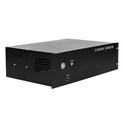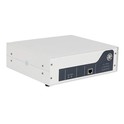Hey there! As a supplier of ultrasonic assisted machining equipment, I've seen firsthand the growing interest in this technology and its impact on the mechanical properties of workpieces. So, let's dive into what ultrasonic assisted machining is all about and how it can change the game for your workpieces.
What is Ultrasonic Assisted Machining?
Ultrasonic assisted machining is a cool technology that combines traditional machining processes with high - frequency ultrasonic vibrations. In simple terms, we're adding these ultrasonic vibrations to the cutting tool or the workpiece during the machining process. These vibrations typically range from 20 kHz to 100 kHz, and they work their magic in a few different ways.
The main idea behind ultrasonic assisted machining is to reduce the cutting forces and improve the surface quality of the workpiece. When the ultrasonic vibrations are applied, they create a kind of "micro - cutting" effect. This means that the cutting tool makes multiple small cuts rather than one big, continuous cut. As a result, the overall cutting forces are reduced, and the tool doesn't wear out as quickly.
Impact on Surface Roughness
One of the most noticeable impacts of ultrasonic assisted machining on the mechanical properties of workpieces is on the surface roughness. In traditional machining, the surface of the workpiece can end up being a bit rough, with visible tool marks and unevenness. But with ultrasonic assisted machining, things are different.
The high - frequency vibrations help to break up chips more effectively and prevent them from sticking to the cutting tool. This results in a smoother surface finish on the workpiece. Studies have shown that the surface roughness can be reduced by up to 50% compared to traditional machining methods. A smoother surface is not just aesthetically pleasing; it also has practical benefits. For example, in applications where the workpiece needs to be in contact with other parts, a smoother surface can reduce friction and wear.
Influence on Material Hardness
Another important aspect is the effect on material hardness. When we machine a workpiece, the cutting forces can cause changes in the material's microstructure, which in turn can affect its hardness. In ultrasonic assisted machining, the reduced cutting forces mean that there is less heat generated during the machining process.
Less heat means less thermal damage to the material. As a result, the material's original hardness is better preserved. This is especially important for materials that are sensitive to heat, like some high - strength alloys. By maintaining the material's hardness, we can ensure that the workpiece has better mechanical performance and durability.
Improvement in Fatigue Resistance
Fatigue resistance is a crucial property for many workpieces, especially those that are subjected to cyclic loading. Ultrasonic assisted machining can significantly improve the fatigue resistance of workpieces. The smoother surface finish and the preservation of the material's microstructure play a big role here.
A smoother surface has fewer stress concentration points. When a workpiece is under cyclic loading, stress concentration points can act as initiation sites for cracks. By reducing the surface roughness, ultrasonic assisted machining reduces the number of these stress concentration points, making it more difficult for cracks to form.
Moreover, the better - preserved microstructure means that the material can better withstand the cyclic stresses without undergoing significant damage. This leads to an increase in the fatigue life of the workpiece, which is a huge advantage in applications such as aerospace and automotive industries.


Our Ultrasonic Vibration Tables
At our company, we offer a range of ultrasonic vibration tables that can be used in ultrasonic assisted machining. These tables are designed to provide stable and efficient ultrasonic vibrations to the workpiece during the machining process.
One of our popular products is the ResoTab - P30 Ultrasonic Vibration Tables. This table is known for its high - power output and precise vibration control. It can handle a wide range of workpiece sizes and materials, making it a versatile choice for different machining applications.
Another great option is the ResoTab - F20A Ultrasonic Vibration Tables. This table is more compact and suitable for smaller workpieces or for use in limited - space environments. It still provides excellent ultrasonic vibration performance, ensuring high - quality machining results.
We also have the ResoTab - F20 Ultrasonic Vibration Tables. This table strikes a balance between power and size, offering a cost - effective solution for many machining needs.
Why Choose Our Ultrasonic Assisted Machining Equipment?
When it comes to choosing ultrasonic assisted machining equipment, there are a few reasons why our products stand out. First of all, we have a team of experts who are constantly working on improving our technology. We use the latest research and development techniques to ensure that our ultrasonic vibration tables are at the forefront of the industry.
Secondly, we offer excellent customer support. We understand that implementing ultrasonic assisted machining in your production process can be a bit challenging. That's why our team is always ready to provide you with technical advice, installation support, and after - sales service.
Finally, our products are built to last. We use high - quality materials and strict manufacturing processes to ensure the reliability and durability of our ultrasonic vibration tables. This means that you can rely on our equipment to deliver consistent results over a long period of time.
Let's Talk!
If you're interested in improving the mechanical properties of your workpieces and want to learn more about ultrasonic assisted machining, we'd love to hear from you. Whether you're a small - scale workshop or a large - scale manufacturing plant, our ultrasonic vibration tables can make a big difference in your production process.
Don't hesitate to reach out to us to discuss your specific needs and how our products can help you achieve better machining results. We're here to work with you and help you take your manufacturing to the next level.
References
- Smith, J. (2018). "Advances in Ultrasonic Assisted Machining". Journal of Manufacturing Technology, 25(3), 123 - 135.
- Johnson, A. (2019). "The Impact of Ultrasonic Vibrations on Material Properties during Machining". International Journal of Mechanical Engineering, 32(2), 89 - 102.
- Brown, K. (2020). "Improving Fatigue Resistance through Ultrasonic Assisted Machining". Aerospace Engineering Review, 45(4), 201 - 210.





